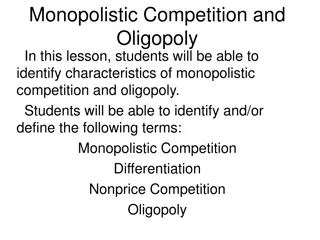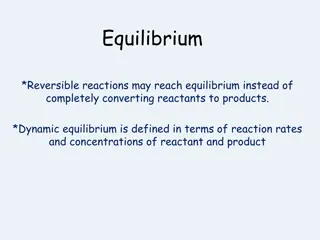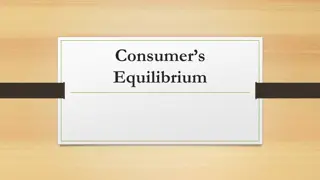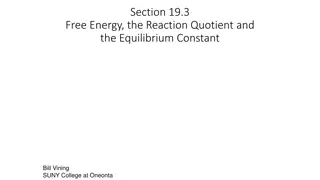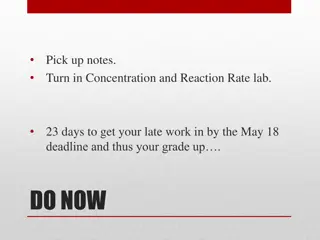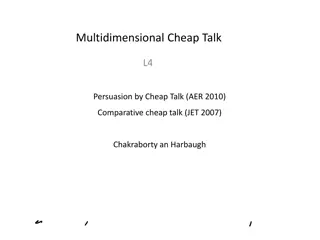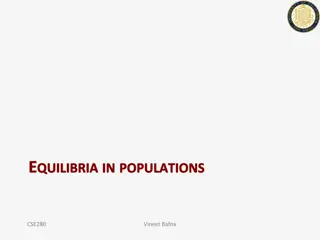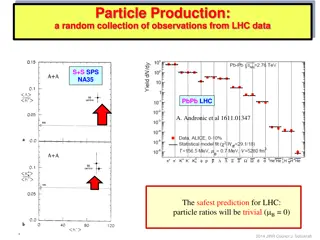Oligopoly Equilibrium Comparison & Cournot vs. Bertrand
This tutorial delves into the comparison between Cournot & competitive equilibrium in oligopoly. Understand profit, output levels, Nash equilibrium, and more in the Cournot vs. Bertrand models of oligopoly.
Download Presentation

Please find below an Image/Link to download the presentation.
The content on the website is provided AS IS for your information and personal use only. It may not be sold, licensed, or shared on other websites without obtaining consent from the author.If you encounter any issues during the download, it is possible that the publisher has removed the file from their server.
You are allowed to download the files provided on this website for personal or commercial use, subject to the condition that they are used lawfully. All files are the property of their respective owners.
The content on the website is provided AS IS for your information and personal use only. It may not be sold, licensed, or shared on other websites without obtaining consent from the author.
E N D
Presentation Transcript
Tutorial 3: Oligopoly Matthew Robson University of York Microeconomics 2 1
Question 1 In comparing the Cournot equilibrium with the competitive equilibrium: a) Both profit and output level are higher in Cournot b) Both profit and output level are higher in the competitive equilibrium c) Profit is higher, and output level is lower in the competitive equilibrium d) Profit is higher, and output level is lower in Cournot 2
Question 1 The competitive equilibrium refers to the Bertrand Equilibrium Both Cournot and Bertrand refer to simultaneous decisions The former to quantity setting, the later to price setting Within the Cournot Equilibrium each firm has to forecast the other firm s output. Then given this forecast, they choose the profit-maximising output for themselves. We then seek an equilibrium where each firm finds their beliefs to be confirmed. At this equilibrium each firm is producing the profit-maximising level of outputs given the output of the other firm. It is the point at which the two reaction curves cross. A reaction curve gives the profit-maximising output, given the other s choice 3
Question 1 Cournot Equilibrium 4
Question 1 In the BertrandEquilibrium firms set the price, and let the market determine the quantity Very simple, at the competitive equilibrium where price equals marginal cost What happens if price is less than marginal cost? Price would never be less than marginal cost, as either firm would increase their profits by producing less What happens if price is more than marginal cost? Any firm can cut their price by any arbitrarily small amount and steal all consumers Hence, the only equilibrium is competitive Bertrand Equilibrium 5
Question 1 In comparing the Cournotequilibrium with the competitive equilibrium: a) Both profit and output level are higher in Cournot b) Both profit and output level are higher in the competitive equilibrium c) Profit is higher, and output level is lower in the competitive equilibrium d) Profit is higher, and output level is lower in Cournot 6
Question 2 Relative to the Nash equilibrium in the Cournot model, the Nash equilibrium in the Bertrand model with homogenous products: a) Results in the same output but a higher price. b) Results in the same output but a lower price. c) Results in a larger output at a lower price. d) Results in a smaller output at a higher price. e) None of the above. 7
Question 2 Relative to the Nash equilibrium in the Cournot model, the Nash equilibrium in the Bertrand model with homogenous products: a) Results in the same output but a higher price. b) Results in the same output but a lower price. c) Results in a larger output at a lower price. d) Results in a smaller output at a higher price. e) None of the above. 8
Question 3 An industry has two firms each of which produces output at a constant unit cost of 10 per unit. The demand function for the industry is ? =1,000,000 ? industry is: . The Cournot equilibrium price for this a) 5. b) 10. c) 15. d) 20. e) 25. 9
Question 3 Firm 1 s Problem ??? ?1= ? ?1,?2?1 ??1 1,000,000 ?1+ ?2 ?1 ??? ?1= ?1 10?1= 1,000,000 10?1 ?1+ ?2 ???????? ????:? ? =? ? ? ? ? ? ,? ? = ?1, ? = ?1+ ?2 2? 1. ?1+ ?2 ?1.1 ?1+ ?2 ?2 ?1+ ?2 1 100,000 ????1= 1,000,000 10 2 1,000,000 2 10 ?2 2= ?1+ ?2 10
Question 3 Similarly, for Firm 2 we have: ?1 1 2= ?1+ ?2 100,000 In equilibrium we know ?1= ?2, therefore: 1 1 4?= 100,000 ?1= ?2= 25,000 ? =1,000,000 50,000 = 20 So d) is correct. 11
Question 4 Suppose that the price elasticity of demand for airline flights between two cities is constant and equal to -1.5. If 4 airlines with equal costs are in Cournot equilibrium for this industry, then the ratio of price to marginal cost in the industry is: a) 8/7. b) 9/8. c) 7/6. d) 6/5. e) None of the above. 12
Question 4 Pricing formula for the Cournot Oligopoly with many firms: ?? ? ? 1 = ?? ?? ?(?) Where, ?? is the market share of firm ?, see the section Many Firms in Cournot Equilibrium in the Varian textbook. Same as for monopolist with ?? term. 1 0.25 ? ? = ?? ?? 1.5 1 1 ? ? = ?? ?? 6 ? ? ?? ?? =6 5 So d) is correct. 13
Question 5 An industry has two colluding firms that act so as to maximize total profit in the industry and then split the profits equally. Firm 1 has cost function ?(?) = 8?. Firm 2 has cost function ?(?) = ?2. Each firm produces an integer number of units. Market demand is given by ? ? = 72 ?. a) b) c) d) e) Each firm should produce 16 units. Firm 1 should produce 32 units and firm 2 should produce 2 units. Firm 1 should produce 14 units and firm 2 should produce 14 units. Firm 1 should produce 28 units and firm 2 should produce 4 units. None of the above. 14
Question 5 The coordination problem is: ??? ?1+2= ?? ? ?1 ? ?2 2 ??? ?1+2= (72 ?1 ?2)(?1+ ?2) 8?1 ?2 ????1= 72 2?1 2?2 8 = 0 ?1+ ?2= 32 ????2= 72 2?1 2?2 2?2= 0 ?1+ 2?2= 36 Therefore, ?1= 28 and ?2= 4 So d) is correct. 15
Question 6 An industry has two firms; a Stackelberg leader and a follower. The price of the industry output is given by ? = 36 ?, where ?is the total output of the two firms. The follower has a marginal cost of 0. The leader has a marginal cost of 9. How much should the leader produce in order to maximize profits? a) 12. b) 18. c) 9. d) 7. e) None of the above. 16
Question 6 The followers problem is: max?2= 36 ?1 ?2?2 0 ????2= 36 ?1 2?2= 0 ?2= 18 ?1 2 The leaders problem is, then: max?1= 36 ?1 ?2?1 9q1 36 ?1 18 ?1 ?1 9q1= 18 ?1 ?1 9?1 2 2 ????1= 18 ?1 9 = 0 ?1= 9 So c) is correct. 17
Question 7 Three firms produce a perfect substitute, and engage in Cournot competition. They face an inverse market demand curve ? = 3 (?1+ ?2+ ?3), where ?is the output price and ??the output level of the i-th oligopolist. Each firm has total costs of ?? 2. a) b) c) Compute the reaction curves. Determine the Nash equilibrium output and profit levels for each firm. Suppose instead that there were Firms 1 and 2 with the same demand and cost functions. Again compute the Nash equilibrium output and profit levels for the two firms. Now turn back to three firms' case. Suppose that Firms 2 and 3 merge and are in Cournotcompetition with Firm 1. The merged firm chooses output levels ?2,?3 to maximize ? ?2 + ?3 ?2 equilibrium output and profit levels. d) 2 ?3 2. Again compute the Nash 18
Question 7a) a) With 3 firms the profits, of the ith firm, are: ??= ??? ?? FOC s are: 2= 3 ?1 ?2 ?3?? ?? 2 3 ?2 ?3 4?1= 0, 3 ?1 ?3 4?2= 0, 3 ?1 ?2 4?3= 0. Thus, the reaction curves are: ?1=3 4 1 4 1 4 1 4?2 1 4?1 1 4?1 1 4?3, ?2=3 4?3, ?3=3 4?2. 19
Question 7b) b) The solution must be symmetric: 3 ?2 ?3 4?1= 0 3 6??= 0 =1 ?? 2 It follows that: 2 ??= 3 3 1 2 1 2 2 ??=1 2 20
Question 7c) c) With only 2 firms: 2= 3 ?1 ?2?? ?? 2 ??= ??? ?? FOC s are: 3 ?2 4?1= 0, 3 ?1 4?2= 0. Thus, the reaction curves are: ?1=3 4 1 ?2=3 4 1 4?2, 4?1. Again symmetry yields: =3 3 5??= 0, ?? 5. 2 ??= 3 6 3 5 3 5 ??=18 , 25. 5 21
Question 7d) d) For Firm 1: 2= 3 ?1 ?2 ?3?1 ?1 2 ?1= ??? ?? ?1=3 4 ?2+ ?3 ???1= 3 4?1 ?2+ ?3 = 0, . 4 However, for Firms 2 and 3: 2= 3 ?1 ?2 ?3(?2+?3) ?2 2 ?3 2 ?2,3= ??? ?? FOC s are: 3 ?1 2 ?2+ ?3 2?2= 0, 3 ?1 2 ?2+ ?3 2?3= 0. Therefore: ?2=1 2 1 6?1= ?3 22
Question 7d) Set reaction curves equal: 1 2 1 6?1+1 2 1 1 2 6?1 6?1 4 ?1=3 =3 4 4 4 6 11 = ?1 ?2,3=1 2 1 6?1=1 2 1 6 11 6 9 22 = ?3 = ?2 Thus: 72 121, ?2= ?3=243 ?1= 484 23
Question 7e) e) Compare the output and profit levels among these three cases. 3 Individual Firms = 0.5, ?? ? = 1.5 ??= 0.5 2 Individual Firms = 0.6, ?? ? = 1.2 ??= 0.72 3 Firms, with 2 and 3 Merged = 0.55, = ?3 = 0.41, ?1 ?1= 0.60, ?2 ?2= ?3= 0.50, ? = 1.37 ? = 0.53 24
Question 7e) Cournot Equilibrium with Many Firms ?? ? ? 1 = ?? ?? ?(?) More Firms 25
Extensions Differentiated Products, not perfect substitutes Sequential Choices over time Drop assumption that firms know the demand and cost functions of the other firm Transition to equilibrium 26




